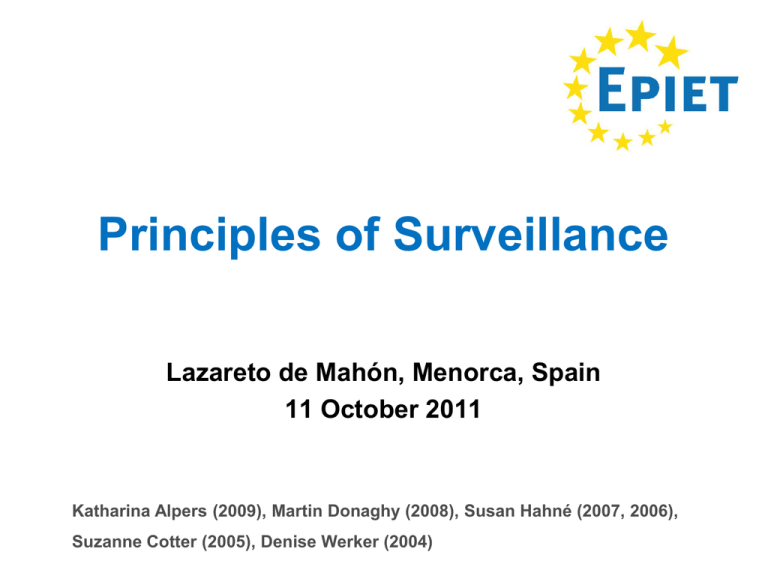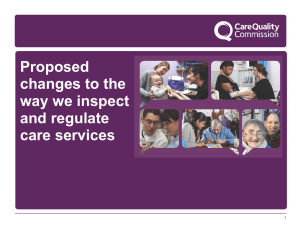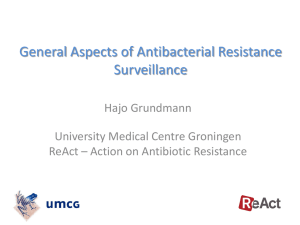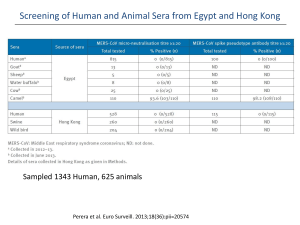29- Principles_of_surveillance_2011
advertisement

Principles of Surveillance Lazareto de Mahón, Menorca, Spain 11 October 2011 Katharina Alpers (2009), Martin Donaghy (2008), Susan Hahné (2007, 2006), Suzanne Cotter (2005), Denise Werker (2004) Content aim of lecture surveillance: context, definitions and history aims of surveillance the process surveillance versus research steps in setting up surveillance criteria for undertaking surveillance challenges & opportunities summary Aim After the lecture, you should be able to… Define: surveillance its three main components Describe: the contexts / historical perspective of surveillance possible aims criteria for undertaking surveillance the difference between surveillance and research the different steps in setting up surveillance some challenges and opportunities Intervention Epidemiology Surveillance Outbreak investigation Applied epidemiological research Surveillance in EPIET Introductory Course Lectures Principles of surveillance Event-based surveillance Analytical tools in surveillance Evaluation of a surveillance system H1N1 surveillance in Europe Case studies Implementation of H1N1 surveillance Surveillance data analysis Evaluation of surveillance systems The Concise Oxford Dictionary n. Close observation, especially of a suspected spy or criminal ORIGIN French, from sur- 'over' + veiller 'watch' Source: The Concise Oxford Dictionary. Ed. Pearsall J. Oxford University Press, 2001. Tools for Control of Communicable Diseases isolation treatment vaccination prophylaxis disinfection quarantine surveillance ‘Close observation of individuals suspected of incubating serious infectious diseases in order to detect initial symptoms of disease in time to institute treatment and isolation’ First use of data for Public Health Action William Farr (1807 – 1883) Superintendent of statistical department, General Register Office, England and Wales Collected, analysed, interpreted vital statistics Described epidemics of infectious diseases Drew conclusions, made recommendations Disseminated information Definition by Alexander Langmuir (1910 – 1993) “Continued watchfulness over the distribution and trends of incidence, through the systematic collection, consolidation and evaluation of morbidity and mortality reports and other relevant data together with the timely and regular dissemination to those who need to know” 21st World Health Assembly (1968) Systematic collection of pertinent data Orderly consolidation and evaluation of these data Prompt dissemination of the results to those who need to know "Information for action" Aims of Surveillance Assess public health status (monitor trends, detect outbreaks) - prevent and control disease Define public health priorities - plan considering impact of hazard, exposure, disease Evaluate public health programmes - take decisions regarding interventions Stimulate or inform research - generate hypotheses, inform methodologie Examples for Interventions manage contacts of a case detect outbreaks early warning design/change vaccination policy design policy re antimicrobial resistance evaluate interventions to improve them certify elimination / eradication Surveillance is a cyclical process Health Care System Public Health Authority Reporting Event Real world! … expected changes Capture Data Analysis & Interpretation Dissemination Intervention Information Surveillance versus Research Surveillance Applies existing knowledge to guide health authorities in the use of known control measures Directly relevant to monitoring and control needs Research Pursues new knowledge from which better control measures will result Systematic investigation, testing and evaluation, designed to develop or contribute to knowledge What we have seen so far Contexts of surveillance Historical perspective Definitions Aims Three main components Surveillance versus research Steps in setting up surveillance (1) 1. Understand the problem 2. Identify opportunities for prevention & control - interventions - target audience 3. Set objectives 4. Specify attributes to meet objectives 5. Design - case definitions & indicators - data needed - data sources - data transfer Steps in setting up surveillance (2) 6. Translate information into action - analyse - interpret - disseminate 7. Evaluate surveillance system 1. Understand the problem - Criteria for priority setting Public Health importance burden of disease (incidence / prevalence) severity, mortality epidemic potential, threat costs, socio-economic impact preventability / opportunities for control intervention programme in place public concern and news-worthiness Feasibility costs availability of data 2. Opportunities for intervention Transmission Exposure 1. Vaccination 6. eg. hygiene precautions, vector control Source infection Infection 2. Prophylaxis 4. Isolation/ treatment Disease 5. Ecological Management 3. Treatment Recovery Death Disability Reservoir 3. Target audiences Public Health professionals Government / Politicians Clinicians / Microbiologists / Control of Infection staff Environmental Health professionals Health service managers Health educators / teachers NGOs Public 3. Set objectives SMART Specific Measurable Acceptable and Action oriented Realistic Time related 3. Set objectives - examples Vague... To estimate the prevalence of hepatitis C To detect outbreaks of measles Specific, measurable, action-oriented & timed To assess the prevalence of hepatitis C in France in order to allow planning of specific health care needs for the coming 20 years To detect early time and place clustering of measles cases in order to ensure timely control of outbreaks 4. Attributes of the system Timeliness Sensitivity Specificity Completeness of information Representativeness Acceptability Keep it as simple as possible!! 5. Design – options Sentinel vs. comprehensive Aggregated vs. individual data Active vs. passive Statutory vs. voluntary Confidential vs. anonymous Basic vs enhanced Indicator based versus event based Security 5. Design – examples of data needed Numerators - number of cases - number of resistant strains Denominators - population under surveillance - live births (CRS) - bacterial isolates (AMR) 5. Design – case definitions Report Lab confirmed Clinical specimen Seek medical attention Symptoms Infected Exposed 5. Design – data set Case Definition -Confirmed – Positive laboratory result -Probable – Clinical + epidemiological link to confirmed case -Possible - Clinical symptoms and signs Demographics -Person, place and time Risk Factors -Exposures -Behaviours Administrative -Time reported -Source 5. Design – issues cost representativeness comparability confidentiality acceptability data quality timeliness commercial sensitivity 5. Design – data sources: health services – Laboratories: frontline diagnostic, reference – Clinical services: physicians, hospital discharge data, disease registries – Screening programmes (antenatal, blood donors) – vaccination programmes – pharmacy / over the counter drugs 5. Design – other data sources Veterinary – animals (domestic, wild) – food Environment – water – food – air Population statistics – deaths – denominators 5. Design – data transfer Existing infrastructure Methods – Paper – Telephone – Electronic – Web-based Frequency Zero reporting 6. Information for Action (1) Analysis – descriptive (time, place, person) – analytical – time series – outbreak detection – molecular epidemiology – geographical information systems (GIS) Interpretation – system and data characteristics and changes – chance, bias, truth – Public health significance 6. Information for Action (2) Dissemination of information – develop outputs in consultation with users – Who needs to know what? – timing – appropriate level of detail – regular review of usefulness – avoid information overload 6. Dissemination of information Alerts -National and local -Europe: EWRS -International: IHR Reports -Bulletins -Annual statements -Scientific journals Internet Public -media 7. Evaluation of surveillance system Does the system do what it set out to do? i.e. meet specified objectives: Contribute to achieving public health goals? Meet the needs of stakeholders to improve policy, services, public understanding? Challenges Surveillance or research needed? Reliability – crude and inaccurate – incomplete – accurate denominators Sustainability – victim of success of control New threats – emerging infections – bioterrorism Timeliness Human Rights / data protection Opportunities Near patient testing Less invasive diagnostics (oral fluid, urine) New molecular typing methods Electronic patient records ‘New’ data sources Behavioural surveillance Syndromic surveillance On-line, web-based systems – data entry – dissemination of information ´New´ analysis methods – GIS – bio-informatics – modelling Summary Context – communicable disease control – epidemiology Definition – systematic collection of data – information for action Aims Process with 3 components – capture – analysis – dissemination Difference between surveillance and research Criteria and steps to set up surveillance system – public health importance – feasibility – information for action Challenges and opportunities






